1,000 Pairs of Hands
Story and Photos by Patti Cook
 Photo: Energetic volunteers pose for a group photo before rolling up their sleeves and getting to work.
Photo: Energetic volunteers pose for a group photo before rolling up their sleeves and getting to work.
Just five years ago, Mala‘ai school garden was covered with kikuyu grass, with no irrigation, no shelter, and nothing good to eat. Today, the work of over 1,000 people contributing thousands of hours of hard work have transformed Mala‘ai into a productive and beautiful sanctuary on the campus of Waimea Middle School (WMS). Our partnership with the garden, which is an independent nonprofit organization, has transformed our school. Imagine this: middle school adolescents (especially boys) ASKING for salads for lunch!
In fall 2009, we harvested more than 2,800 pounds of Kabocha pumpkins and more than 300 pounds of other produce, including kalo (taro), mint, lemongrass, basil, artichokes, radishes, cassava, ‘uala (sweet potatoes), green beans, green onions, perennial cabbage greens, kale, sorrel, arrugula, lettuce, sweet and chili peppers, yacon, sun chokes, cucumber, tomato, guava, tangerine, turmeric, sage, lemon verbena, New Zealand spinach, parsley, cilantro, mulberries, and pineapple. We also have grown many beautiful flowers and have given a number of plants and seeds including mulberry trees, kalo huli, Kabocha seeds, beans, and cassava starts to students and community friends for planting in their home gardens. Under the direction of Amanda Rieux, our Garden Leader, and with the assistance of teachers and community volunteers, we provide classes to more than 300 WMS students each school semester.
 Photo: Amanda provides the group with a brief history of the garden prior to laying out the day’s work.
Photo: Amanda provides the group with a brief history of the garden prior to laying out the day’s work.
The Kaiser Permanente work day on MLK Day was a great success. A slight mist hid Mauna Kea and our pu‘u (hills) from view most of the morning, but the cool weather didn't discourage anyone. We counted nearly three dozen participants in all. The work accomplished was impressive—it’s amazing to see what 35 pairs of hands working together for almost 3 hours can do! We were especially pleased that a couple of our students came with family members, and they seemed to thoroughly enjoy themselves and asked to take home seeds for their home gardens.
Photo: Volunteers gather grass clippings to use as mulch.
We trust that the Waimea Kaiser doctors and clinic staff and their families discovered the pleasure and rewards of gardening and how it connects to health and wellness, for both students and families, as well as for the entire community. Dr. Lois Gregg and Dr. Jeffrey Tolan, family practitioners at the Kaiser Permanente Waimea Clinic, really got into the spirit of the day, getting down on their hands and knees to help weed. We are hopeful they'll be back—especially since our 3/4-acre organic garden is located just footsteps away from Kaiser’s Waimea clinic. Mahalo to everyone from Kaiser, who brought T-shirts for everyone, as well as sunscreen, lip balm, hand sanitizer, and sun hats.
Photo: Kaiser Permanente physician Dr. Jeffrey Tolan weeds around the edges of the Mala‘ai garden windbreak.

The fresh fruit morning snack and Merriman's lunches were wonderful—everyone thoroughly enjoyed them! We all worked up a good appetite after nearly three solid hours of gardening. Merriman’s served two different wraps: a stir-fried fresh vegetable wrap including snap peas, broccoli, mushrooms, onions, carrots, beans, and much more with a green salad and a garnish of fresh corn relish, and a fresh island fish wrap, grilled and wrapped with greens. They were absolutely delicious and all locally grown. We also enjoyed lemongrass tea and lilikoi-mint tea—both made from ingredients grown in the garden.
At the end of the day, Amanda Rieux, Mala‘ai Garden Leader, invited each volunteer to make a wish for the garden by writing it on a flag which will be unfurled at our 5th anniversary celebration for the garden on March 3, 2010. Everyone’s flags will be raised up on bamboo poles in the garden to send their wishes flying off into the universe. When the words fade away, they say the wishes will have been received and accepted!
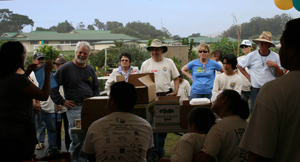 Photo: Amanda invites volunteers to make a Malama ‘Āina wish flag for Mala‘ai school garden.
Photo: Amanda invites volunteers to make a Malama ‘Āina wish flag for Mala‘ai school garden.
Of course, we owe a big mahalo to Nancy Redfeather and The Kohala Center for helping to make this event possible. Mala‘ai is part of the Hawai‘i Island School Garden Network (HISGN), the umbrella organization that made the initial arrangements for this garden work day with Kaiser. We are very grateful for the help and support we receive virtually every single day from Nancy Redfeather on behalf of HISGN and The Kohala Center. It's a most valued partnership!
We also thank Vivienne Aronowitz, who is both a Kaiser Permanente nutritionist and a Mala‘ai school garden board member, for encouraging this new partnership. Last, but not least, we thank the students and their families and also the many community volunteers who came out to support Mala‘ai: The Culinary Garden of Waimea Middle School. We cannot imagine a better way to celebrate ‘Ike ‘Āina (knowledge of the land) and to honor Martin Luther King’s vision that, by serving others, we all benefit.

Once in a Lifetime Experiences
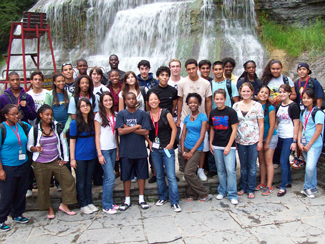 Photo: A group photo of all participants in the 2009 CATALYST Academy. These students came to Cornell from places across the U.S. and around the world.
Photo: A group photo of all participants in the 2009 CATALYST Academy. These students came to Cornell from places across the U.S. and around the world.
The CATALYST Academy is a one-week residential engineering program for high school freshman, sophomore, and junior boys and girls who share a strong interest in engineering and its related disciplines. From July 18–24, they will engage in classes, lab sessions, and research projects led by the university’s faculty and graduate students on the Cornell campus in Ithaca, New York. Additional social events, panel discussions, and field activities provide student participants with opportunities to network with Cornell faculty, staff, and university students.
Scholarship applicants for CATALYST Academy must be current freshman, sophomores, and juniors with a minimum cumulative GPA of 3.0 on a 4.0 scale.
The Kohala Center made it possible for me to attend a summer program at Cornell University where a variety of engineering fields were unfolded before me. I met other people my age with similar ambitions as myself whom I still have strong relationships with. I am finding that the things that I learned there are being taught to me back at my school. Not even my biology teacher can say that she has done gel electrophoresis or applied the polymerase chain reaction to actual genetic engineering. From this program, I gained once in a lifetime experiences which I will remember forever. –Noa Flaherty, current junior at Hilo High and 2009 CATALYST Academy scholarship recipient
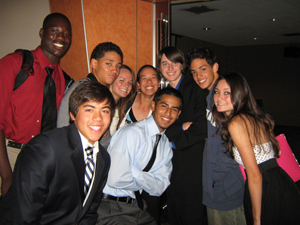 Photo: A group shot of Noa Flaherty (standing, 3rd from right) with new friends at last summer’s CATALYST Academy.
Photo: A group shot of Noa Flaherty (standing, 3rd from right) with new friends at last summer’s CATALYST Academy.
The CURIE Academy, July 18–24, is a one-week residential engineering program for high school girls who excel in math and science. The program is geared to sophomores and juniors who may not have had prior opportunities to explore engineering, but who want to learn more about the field. Cornell University's world-renowned faculty and graduate students will lead CURIE participants in classes, lab sessions, and project research. Social events, panel discussions, and other out-of-classroom activities will provide participants with opportunities to network informally with Cornell faculty, staff, and students.
Current sophomore and junior girls with a minimum cumulative GPA of 3.0 on a 4.0 scale and advancement through least Algebra II and three science courses by the end of the current academic year are eligible to apply to the CURIE Academy.
The Kohala Center is offering two partial tuition and travel scholarships to either the CATALYST or the CURIE Academy. Applicants may apply for one or both of the programs. The application deadline is 5 p.m. Friday, February 26. For application details and to download forms, visit http://www.kohalacenter.org/cornellsummer.html. For additional information, contact Samantha Birch at sbirch@kohalacenter.org or 808-443-2755.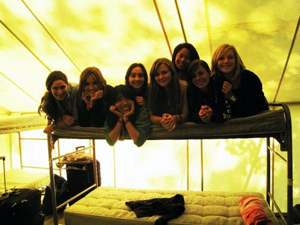
Scholarships to the Brown University Environmental Leadership Lab (BELL) in Rhode Island are also available for high school students who are interested in biology, geology, and environmental science and policy.
BELL is a unique outdoor learning laboratory. Students from across the country engage in intensive leadership development activities and learn about sustainable development and field ecology through the academic fields of biology, geology, and environmental science and policy. For two-week sessions, students will live at the university’s Haffenreffer estate, a 372-acre historic farm adjacent to Narragansett Bay, which is among the most diverse and biologically productive ecosystems on Earth.
BELL consists of three separate sessions:
- BELL Sustainable Development, June 28–July 9
- BELL Sustainable Development, July 12–July 23
- BELL Field Ecology, July 26–August 6
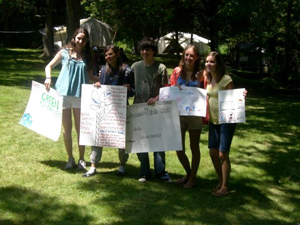
Photo: Jessica Bazilay, Katrina Bantis, Maxime Rappaport, Annie Bennet, and Rachel Meyer display their Action Plan posters at the end of the 2009 BELL session. Photo by Grace Franchini.
In the Sustainable Development program, students learn how human demands on the environment can compromise the long-term health of ecosystems that exist to sustain us. Students develop the leadership necessary for tackling environmental problems within their home communities. They also learn about policies, practices, and emerging technologies that help to reduce human ecological impact.
Students participating in the Field Ecology program examine the science behind current environmental issues and learn about current environmental science research. They also participate in an ongoing research project and practice designing an experiment and analyzing and reporting scientific data.
The BELL application deadline is 5 p.m. Friday, February 26. For details and to download application forms, visit http://www.kohalacenter.org/bellRI.html. For more information, contact Samantha Birch at sbirch@kohalacenter.org or 808-443-2755.
Nāhelehele Dry Forest Symposium
The Nāhelehele Dry Forest Symposium is a project of Ka‘ahahui ‘O ka Nāhelehele, a nonprofit organization dedicated to revitalizing dryland native plant communities in Hawai‘i. Partners in sponsoring this conference are Bishop Museum’s Amy B.H. Greenwell Ethnobotanical Garden, Hawai‘i Wildfire Management Organization, Kamehameha Schools-Land Assets Division, The Kohala Center, Leonard Bisel Associates, National Tropical Botanical Garden, and the Outrigger Keauhou Beach Hotel.

Photo: Sam Gon (left) and Art Medeiros in the dry forest of Auwahi on leeward Haleakalā. Art is a champion of dry forest restoration on Maui. They are standing under a large ‘ohe makai (Reynoldsia sandwicensis), a tree adapted for very arid summers which drops its leaves during the hottest time of year (summer deciduous). The wood is light and strong and was used for making stilts (kūkulu ‘ae‘o), so another name for the tree is ‘ohe kūkulu ‘ae‘o.
Climate change and its effects on Hawaiian dry forest will be the subject of a morning talk by David Burney, director of conservation at the National Tropical Botanical Garden. Climate models suggest that greenhouse gas-driven change will result in warming of mid-Pacific islands, sea-level rise, falling water tables and probably increased dryness in the lowlands and a decreased area of high rainfall on mountains. Successful plant reintroduction strategies are needed to buffer against climate uncertainty through use of micro-irrigation, creation of new populations in suitable habitat, and possibly assisted migration strategies. Burney will discuss flexible and affordable ideas about saving as many species and ecological functions as possible.
Not all seedlings are equal, and Anthony Davis from the Center for Forest Nursery and Seedling Research at the University of Idaho will talk about growing the right plant for the site to improve outplanting success. To maximize plant establishment success, a seedling should be grown with the conditions at the outplanting site in mind. However, even with better methods, it isn’t realistic to think that every field recovery effort for the nearly 300 endangered plants in Hawai‘i will be successful. Bruce Keobele of Ka‘ala Farm will propose backyard preservation as insurance for endangered plant recovery. Although backyard preservation is not as desirable as preservation in the wild, it can serve an important role in preservation efforts. Since 1998, when it became legal in Hawai‘i for the public to possess endangered plants, only 20% of these species has been commercially sold. Koebele will explore the reasons for this, including rarity of source material, misconceptions about commercial nursery and public interests and abilities, and endangered plant tag issuance.
The symposium’s afternoon session will include a variety of talks about threats to Hawai‘i’s native plants. CTAHR invasive weed specialist Jim Leary will discuss invasive weed management. Lisa Ellsworth from the University of Hawai‘i at Mānoa will talk about the interaction of non-native grasslands, fire, and native plants. Hawai‘i Department of Agriculture insect specialist Pat Conant will discuss insect threats to native plants, including a timely update on the naio thrip, a new pest introduced to Hawai‘i Island in spring 2009.
The challenges of large-scale restoration projects will be explored by Grant Gerrish of UH Hilo, and Melora Purell, the coordinator for the Kohala Watershed Partnership. Gerrish will talk about endangered plant preserves at the Villages of La‘i‘ōpua, a DHHL housing project on the dry, leeward slopes of Hualālai. Twenty-one species of native plants occur here, including the critically endangered aupaka shrub and uhiuhi. Purell’s talk, titled “Watershed Restoration in a Moonscape: It's all about the Plants,” will cover key considerations for large-scale dryland watershed restoration projects. These include choosing the plant pallet, finding seed and water sources, and creating a flexible and efficient planting design. The Pelekane Watershed Management Project includes restoration of 400 acres of native vegetation along 6 miles of stream corridors and installation of 100,000 native plants.
Three hands-on workshops will be held preceding the symposium on Thursday, February 25. Workshops will cover native plant propagation techniques, identifying and dealing with invasive weeds, and the role of fire mitigation in native plant conservation. The plant propagation workshop will be held at Amy Greenwell Ethnobotanical Garden, led by propagation specialists from around Hawai‘i. Presenters will discuss successes and failures in propagation efforts and provide some hands-on experience with propagation techniques. A visit to the Waikoloa dryland forest project that is protecting a wili wili forest, as well as a third of the remaining endangered uhiuhi population will illustrate how the Waikoloa Outdoor Circle is mitigating significant wildfire threats to their restoration and preservation project. Hawai‘i Wildfire Management Organization will share what they are learning about the vegetation succession that has been occurring since the 2007 wildfires burned over 10,000 acres of the Waikoloa plains. The invasive weed workshop will provide an opportunity to identify invasive weeds, discuss their effects on native plants, brainstorm about weed control, and more.
The symposium will take place on February 26 from 9 a.m. until 5 p.m. at the Outrigger Keauhou Beach Hotel. For registration and information, visit http://www.kohalacenter.org/nahele10.html or call The Kohala Center at 808-887-6411. Conference registration, including lunch, is $50. After February 12, symposium registration increases to $65. Workshops on February 25 are $25 each. Workshop participation is limited and no registrations will be accepted after February 12.

